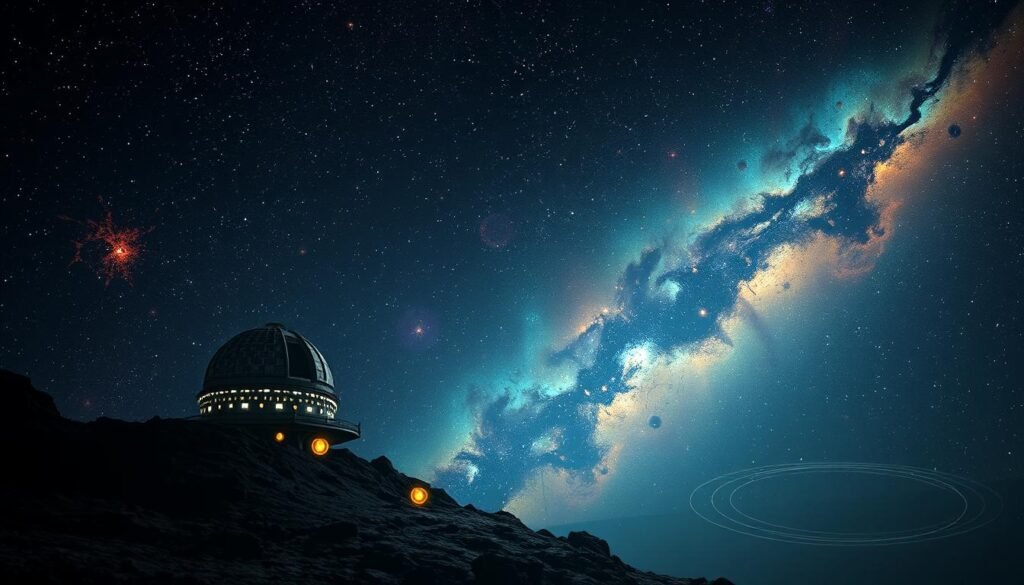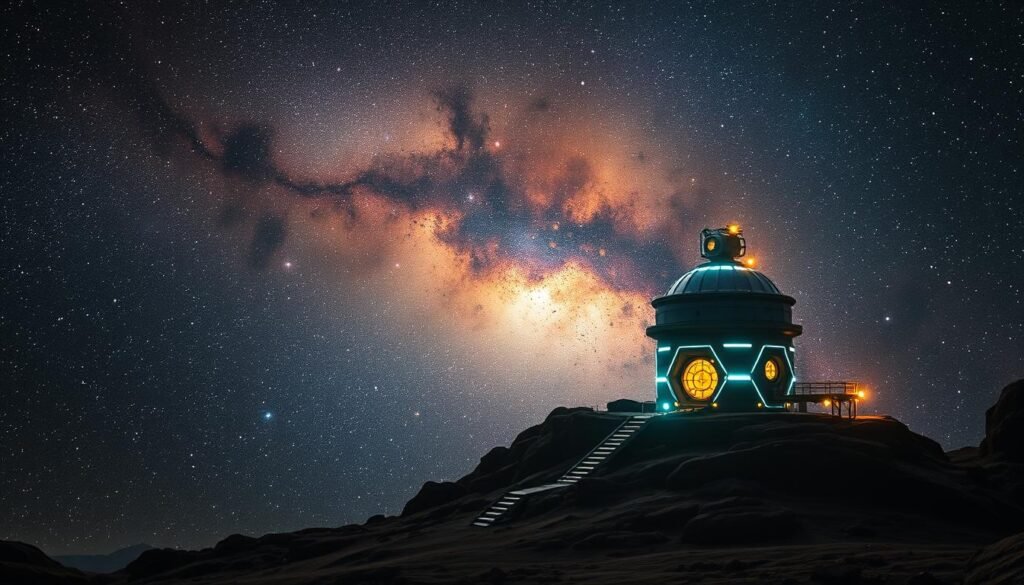What lies beyond our cosmic exploration? For 60 years, NASA has been exploring the universe. They use telescopes and satellites to uncover space curiosities and wonders.
The discovery of dark matter, dark energy, and exoplanets has sparked more questions. It leaves us in awe and curiosity about the mysteries around us.
As we explore the unknown, we see the importance of cosmic exploration. With thousands of exoplanets found, and the James Webb Space Telescope on the horizon, we’re on the brink of a new era. The universe’s mysteries are complex and need more research to solve.

Key Takeaways
- The universe is full of mysteries waiting to be uncovered through cosmic exploration
- Dark matter and dark energy make up a significant portion of the universe’s mass-energy content
- Exoplanets come in a wide variety of sizes and characteristics, with some located in the habitable zone of their stars
- The James Webb Space Telescope is set to revolutionize our understanding of the early universe and star formation
- Continued research and exploration are necessary to unravel the secrets of the universe and its many space curiosities
- Astronomical wonders and celestial enigmas continue to captivate human imagination and inspire further discovery
The Infinite Expanse: Understanding Our Cosmic Home
As we explore the universe, we find many cosmic phenomena that amaze and puzzle us. The universe is full of mysteries, with many things still unknown. Recent studies have given us new insights into the universe’s structure and makeup.
The universe is a complex mix of mysteries, with many questions left unanswered. By studying what we can see, we learn about the universe’s size, shape, and what it’s made of. Cosmic distances are measured by observing objects and analyzing their light.
The Observable Universe vs. The Unknown
Understanding the universe is hard because of the difference between what we can see and what we can’t. The observable universe is what we can study, while the unknown is beyond our reach. By exploring what we can see, we learn more about the universe and its mysteries.
Measuring Cosmic Distances
Measuring distances in the universe is key to understanding it. By looking at the light from objects, we can figure out how far away they are and how fast they’re moving. This helps us make detailed maps of the universe, showing where galaxies and other structures are.
The Universe’s Structure
The universe’s structure is complex and always changing. It includes many things like galaxies, stars, and the universe’s expansion. By studying the universe, we can solve many mysteries and understand its structure better.
| Cosmic Phenomena | Description |
|---|---|
| Galactic Puzzles | Unsolved mysteries of the universe, including dark matter and dark energy |
| Mysterious Universe | The unknown regions of the universe, including the nature of cosmic phenomena |
| Cosmic Enigmas | Unexplained phenomena, including the formation of galaxies and stars |
| Unknown Phenomena | Unobserved regions of the universe, including the possibility of extraterrestrial life |
Dark Matter: The Invisible Force Shaping Our Cosmos
Dark matter has long been a mystery to scientists and astronomers. It makes up about 27% of the universe’s mass-energy density. We can feel its presence through its gravitational pull on galaxies and galaxy clusters.
This makes dark matter a key part of cosmic discoveries and celestial phenomenon exploration.
Studying dark matter helps us understand how galaxies form and stay stable. Space discovery has shown its importance in the universe. Galaxies’ rotation curves suggest there’s unseen mass.
But, finding dark matter particles is still a challenge. Yet, cosmic microwave background observations hint at its early universe distribution.
Some key facts about dark matter include:
- Dark matter constitutes about 27% of the universe’s total mass and energy
- Ordinary matter comprises only about 5% of the universe’s total mass and energy
- Dark matter plays a crucial role in the formation and stability of galaxies and galaxy clusters
Gravitational lensing effects show dark matter’s significant role in the universe’s structure. As scientists delve deeper into dark matter secrets, they uncover new insights. This advances our understanding of cosmic discoveries, celestial phenomenon exploration, and space discovery.
| Component | Percentage of Universe’s Mass-Energy Density |
|---|---|
| Dark Matter | 27% |
| Ordinary Matter | 5% |
Black Holes: Cosmic Portals of No Return
Black holes are truly fascinating and mysterious. They are like cosmic portals that have caught our imagination. These areas in space are made when huge stars collapse under their own weight, creating a singularity with an event horizon. Learning about black holes helps us solve space riddles and celestial puzzles that have puzzled astronomers for ages.
The birth and growth of black holes involve gravity, matter, and energy. Astral mysteries around black holes have sparked many research studies and observations. For example, in April 2019, scientists imaged a supermassive black hole in galaxy M87. This was a big breakthrough that shed light on black holes’ role in the universe.
Formation and Evolution
Black holes come into being when massive stars collapse. This creates a singularity with an incredibly strong gravitational pull. The event horizon, which marks the boundary beyond which nothing can escape, is key to black hole physics. Understanding how black holes form and evolve helps us grasp the cosmic portals that control matter and energy in the universe.
Supermassive Black Holes
Supermassive black holes, found at the centers of galaxies, are crucial. They shape their surroundings and affect galaxy formation and evolution. Studying these black holes is vital to unraveling space riddles and celestial puzzles that govern galaxies and galaxy clusters.
| Black Hole Type | Mass | Location |
|---|---|---|
| Stellar Black Hole | 10-20 solar masses | Galactic centers |
| Supermassive Black Hole | Millions-billions of solar masses | Galactic centers |
Research on black holes is ongoing, with scientists using various methods to study them. By exploring astral mysteries and cosmic portals, researchers aim to deepen our understanding of the universe. They seek to solve space riddles and celestial puzzles that have puzzled us for centuries.
The Big Bang: Birth of Everything We Know
The big bang theory explains how the universe started and grew. It says the universe was once an infinitely hot and dense point. This point expanded rapidly about 13.8 billion years ago.
Many pieces of evidence support this theory. These include the cosmic microwave background radiation and the abundance of light elements.
Space exploration has helped us learn more about the universe’s cosmic origins. The Big Bang theory helps us understand how the universe evolved. It shows how the first particles formed and how complex structures emerged.
The universe birth is complex and still somewhat mysterious. But scientists keep improving our understanding with ongoing research and observations.
- The cosmic microwave background radiation, which is thought to be the residual heat from the initial explosion.
- The abundance of light elements, such as hydrogen and helium, which were formed during the first few minutes after the Big Bang.
- The large-scale structure of the universe, which is thought to have evolved from the gravitational collapse of small fluctuations in the density of the universe.
As we explore the universe more, we might learn new things about it. The Big Bang theory is a key part of modern astrophysics and cosmology. It helps us understand the universe and our place in it.
Universe Mysteries That Challenge Modern Physics
The universe is full of mysteries that push our understanding of physics to the limit. Questions like quantum entanglement, string theory, and the multiverse theory keep scientists busy. These mysteries are part of the secrets of the universe that we’re still trying to figure out.
Scientists are studying strange things in our solar system, like dark matter. It makes up about 85% of all matter in the universe. We know it’s there because it affects visible matter, like bending light. But finding dark matter directly is a big challenge in astrophysics.
Quantum Entanglement
Quantum entanglement is when particles connect and can affect each other, even across vast distances. This idea makes us question our understanding of space and time. It raises many questions about what reality really is.
String Theory Implications
String theory says the universe’s basic building blocks are one-dimensional strings, not tiny particles. This idea changes how we see the universe. It could mean there are more dimensions and even a multiverse.
The Multiverse Theory
The multiverse theory says our universe is just one of many, possibly endless, universes. This idea makes us wonder about reality and our place in it. It’s another mystery that challenges our modern physics.
Celestial Phenomena: Nature’s Cosmic Light Show
The universe is full of amazing celestial phenomena, like supernovae and black holes. These space wonders show us the beauty and complexity of the cosmos. They remind us of the mysteries still out there, with astronomical events like galaxy collisions and star formations.
Some key celestial phenomena include supernovae, black holes, and neutron stars. For example, scientists have seen the merger of stellar-mass black holes. The NANOGrav experiment has also found hints of gravitational waves from supermassive black hole mergers. This helps us understand the nature’s light show in the universe.
It’s important to study these astronomical events to learn about the universe. By looking at celestial phenomena, scientists can understand how galaxies, stars, and planets form and evolve. This research can also teach us about the laws of physics and how matter and energy behave in extreme conditions.
Some main areas of research in celestial phenomena include:
- Supernovae and their role in shaping the universe
- Black holes and their impact on the surrounding space
- Neutron stars and their unique properties
- Gravitational waves and their detection
By exploring and studying celestial phenomena, we can learn more about the universe. This helps us uncover the secrets of nature’s light show and the space wonders around us.

Dark Energy: The Force Behind Universal Expansion
Dark energy is a mysterious force that makes the universe expand faster. It’s spread all over, making up about 68% of the universe’s mass-energy. Studies like the European Space Agency’s dark energy survey in 2013 and the National Science Foundation’s Dark Energy Survey in June 2021 support this idea.
The makeup of the universe is quite interesting, with dark energy being a big part. It’s found that the universe is made up of 5% normal matter, 27% dark matter, and 68% dark energy. The discovery of dark energy has changed how we think about gravity and mass in the universe.
Discovery and Evidence
Scientists use many ways to study dark energy, like looking at cosmic microwave background radiation. This radiation helps find dark energy in the universe. NASA’s Fermi Large Area Telescope (LAT) also scans for gamma-rays to learn more about dark energy and dark matter.
Studying dark energy is very important for understanding the universe. It’s thought to push objects apart, working against gravity’s pull. This has sparked a lot of scientific interest and thought about its nature and effects on the universe, including universal expansion and space mysteries.
Future Implications
As scientists keep studying dark energy, they’re also thinking about its future effects. Some ideas say dark energy could make the universe expand even faster. This could lead to big changes like the Big Rip or the Big Crunch. Learning about dark energy is key to understanding the cosmic forces that shape our universe.
Galactic Enigmas: Strange Objects in Space
The universe is full of galactic enigmas, like fast radio bursts and gamma-ray bursts. These show how complex and unpredictable the cosmos is. They are a big part of the space mysteries that scientists and astronomers find fascinating.
Some of the most interesting cosmic puzzles include supermassive black holes, dark matter, and dark energy. For instance, supermassive black holes are at the heart of many galaxies, including our own Milky Way. They can be millions or even billions of times more massive than our Sun.
Here are some key facts about these galactic enigmas:
- Supermassive black holes are a type of strange object that can affect the movement of stars and gas within a galaxy.
- Dark matter is a type of matter that does not emit, absorb, or reflect light, making it invisible and detectable only through its gravitational effects.
- Dark energy is a mysterious energy that is thought to be responsible for the accelerating expansion of the universe.
Understanding these space mysteries and cosmic puzzles is key to uncovering the universe’s secrets. It helps us learn about its origins, evolution, and what the future holds.
| Phenomenon | Description |
|---|---|
| Fast Radio Bursts | Brief, intense pulses of radio energy from distant galaxies |
| Gamma-Ray Bursts | Explosions of massive stars that release enormous amounts of energy |
| Supermassive Black Holes | Black holes with masses millions or billions of times that of the Sun |
The Search for Extraterrestrial Intelligence
The search for extraterrestrial intelligence (SETI) is a long-term effort to find signs of life beyond Earth. It has raised many cosmic questions, pushing space exploration forward. The Fermi paradox, asking “Where is everybody?” is a key question in this field.
SETI projects have been around for decades, starting with Project Ozma in 1960. Today, projects like SETI@home and Breakthrough Listen use new tech to scan for signals. The SETI Institute got a big boost in 2023, with a $200 million donation to help their work.
Some main areas in the search for extraterrestrial life include:
- Analyzing radio signal data for signs of intelligent life
- Searching for technosignatures like fast radio bursts (FRBs) and unique light patterns
- Using advanced radio telescopes like the Green Bank Telescope and the Parkes Telescope
As we explore the universe, we might find answers that change how we see the cosmos. The search for extraterrestrial intelligence is an exciting journey. It could lead to big breakthroughs in space exploration and change our understanding of the universe.

| Project | Description |
|---|---|
| SETI@home | Analyzes radio signal data with the help of millions of volunteer computers worldwide |
| Breakthrough Listen | Utilizes advanced radio telescopes to search for technosignatures |
| SETI Institute | Received a $200 million donation in 2023 to support research and infrastructure development |
Time, Space, and Gravity: Einstein’s Legacy
Albert Einstein changed how we see time, space, and gravity. His ideas still guide us today, from black holes to the universe’s growth. The discovery of gravitational waves in 2015 by LIGO proved a key part of his theory.
Einstein’s ideas have big effects, with cosmic forces like gravity shaping our universe. Some key points of his legacy are:
- Gravitational waves, predicted by Einstein, were first detected in 2015 by LIGO.
- The supermassive black hole at the center of the M87 galaxy has a mass equal to six and a half billion Suns.
- Gravitational wave astronomy offers a transformative tool for exploring the most energetic and violent events in the universe.
Einstein’s work is key to modern science, like cosmology and particle physics. His theory of relativity is a mainstay of our universe’s understanding. As we delve into time, space, and gravity, Einstein’s legacy reminds us of human curiosity and ingenuity.
| Concept | Description |
|---|---|
| General Relativity | Describes gravity as a curvature of spacetime due to mass. |
| Gravitational Waves | Ripples in the fabric of spacetime produced by violent cosmic events. |
| Cosmic Forces | Gravity, electromagnetism, and other forces that shape the universe. |
The Future of Universe Exploration
As we explore the universe, we’re seeing big tech leaps. These advancements let us study the cosmos in new ways. Advanced telescopes have opened up the universe to us, revealing secrets we never knew existed.
The dream of interstellar travel is getting closer. Scientists and engineers are working hard to make new ways to travel. This could change how we see the universe, letting us visit distant stars and find new planets.
Recent space wins include India’s Aditya-L1 solar mission and China’s Chang’e 6 Moon mission. These missions show how fast we’re moving in universe exploration. They also show us what’s possible in the future.
The future of universe exploration is bright. Missions like the NISAR satellite will help us learn more about space. As we keep exploring, we’ll find new secrets. This will inspire the next generation of scientists and engineers.
| Mission | Objective | Outcome |
|---|---|---|
| Aditya-L1 | Solar observatory mission | Achieved orbit at Lagrange point L1 |
| Chang’e 6 | Collect soil samples from the far side of the Moon | Collected 1.9 kilograms of soil samples |
Conclusion: Embracing the Unknown
Exploring the humbles us with the yet to be found. Scientists and space agencies have uncovered many . These discoveries inspire and amaze us.
Quantum mechanics and the multiverse theory are mind-bending. Black holes and the Big Bang are awe-inspiring. The universe is full of complexity and mystery. Each new finding pushes us to understand existence better.
has grown our scientific knowledge and enriched our lives. Space technologies improve our daily lives and industries. They also bring nations together, fostering global cooperation.
The universe’s mysteries call to us, urging us to explore with curiosity and wonder. Our drive to discover keeps us learning and growing. This way, we can uncover more and expand our knowledge.
FAQ
What are some of the biggest mysteries and enigmas of the universe?
The universe is full of mysteries. These include dark matter, black holes, and the Big Bang. Also, quantum entanglement and string theory are big puzzles. Scientists and space fans are still trying to solve these cosmic riddles.
How do we measure the size and scale of the observable universe?
To measure the universe, we use methods like parallax and red shift. We also use objects like Cepheid variables and supernovae. These help us figure out how far away things are and what the universe looks like.
What is the role of dark matter in shaping the universe?
Dark matter is a mysterious substance that makes up most of the universe. It helps form galaxies and galaxy clusters. But, scientists still don’t know much about it.
How do black holes form, and what are the latest discoveries about these cosmic phenomena?
Black holes form when stars collapse. They have such strong gravity that nothing escapes. New discoveries have shown how black holes grow and exist at galaxy centers. They also found something called Hawking radiation.
What is the evidence supporting the Big Bang theory, and how has our understanding of the universe’s origins evolved?
The Big Bang theory says the universe started expanding from a hot, dense state. Evidence like the cosmic microwave background and the abundance of light elements supports it. Research keeps improving our understanding of the universe’s early days.
What are some of the mysterious phenomena that challenge our current understanding of physics?
Phenomena like quantum entanglement and string theory push our scientific limits. They challenge our understanding of the universe and the laws of nature. Studying these could lead to new discoveries.
What are some of the fascinating celestial phenomena that can be observed in the universe?
The universe has many amazing sights, like star births and deaths. We also see galaxies forming and strange objects like pulsars. Studying these can give us new insights into the universe.
What is the role of dark energy in the expansion of the universe, and what are the latest discoveries in this field?
Dark energy is a force that makes the universe expand faster. It’s a big mystery in cosmology. Recent studies have given us new clues about dark energy and its role in the universe’s future.
What are some of the strange objects and phenomena observed in the galaxies of the universe?
Galaxies have many enigmatic objects, like quasars and dark matter halos. Unraveling these mysteries is a challenge for astronomers. It offers new chances for discovery and understanding the cosmos.
What is the Fermi paradox, and how does it relate to the search for extraterrestrial intelligence?
The Fermi paradox questions why we haven’t found alien life, despite the odds. It has sparked a renewed interest in searching for extraterrestrial life. Scientists are looking for signs of life beyond Earth.
How have Einstein’s theories of space, time, and gravity shaped our understanding of the universe?
Einstein’s theories have changed how we see space, time, and gravity. They explain how gravity warps spacetime and how time behaves near massive objects. Einstein’s work continues to inspire cosmic exploration.
What are some of the exciting possibilities for the future of universe exploration?
The future of exploring the universe is bright. New telescopes and technologies are on the horizon. We might even travel to other stars. The next few decades will be exciting for space discovery.
Source Links
- https://www.nasa.gov/specials/60counting/universe.html
- https://www.schooltube.com/mysteries-at-the-edge-of-our-universe-a-journey-into-the-unknown-2/
- https://www.ultra-unlimited.com/blog/beyond-dark-matter-a-holographic-exploration-of-the-conscious-cosmos
- https://arxiv.org/pdf/2307.05507
- https://vinodsblog.com/2023/05/22/dark-matter-a-deep-dive-into-the-powerful-theories/
- https://www.linkedin.com/pulse/from-dark-light-how-understanding-universes-mysteries-doug-hohulin-d76ic
- https://www.skyatnightmagazine.com/space-science/biggest-mysteries-universe
- https://www.theguardian.com/science/2011/oct/23/brian-cox-jeff-forshaw-answers
- https://digitaldominationmusic.com/space-a-visual-journey/
- https://vocal.media/earth/cosmic-chronicles-unveiling-the-universe-s-untold-stories
- https://paulroebuck.co.uk/blog/darkmatter
- https://www.skyatnightmagazine.com/space-science/what-we-dont-know-about-universe
- https://www.smithsonianmag.com/science-nature/top-ten-mysteries-of-the-universe-83272912/
- https://amigoenergy.com/blog/dark-energy-and-dark-matter-explained/
- https://www.astronomy.com/science/10-modern-mysteries-of-the-universe/
- https://www.sciencefocus.com/space/the-universes-7-biggest-mysteries-and-why-theyre-unsolved
- https://listverse.com/2023/05/19/top-10-mind-bending-unsolved-mysteries-of-the-universe/
- https://alienint.com/seti-progress
- https://www.seti.org/exploring-stars-rwanda-astronomers-journey-international-space-week
- https://www.goodreads.com/book/show/16149726-unraveling-the-universe-s-mysteries
- https://editverse.com/gravitational-waves-einstein/
- https://medium.com/@matchmaticians/the-mathematical-foundations-of-einsteins-revolutionary-work-29aa50f01d10
- https://www.ucf.edu/space/
- https://timesofindia.indiatimes.com/science/space-time-of-2024-top-exploration-milestones-of-the-year/articleshow/116831899.cms
- https://www.earthandspaceexpeditioncenter.org/how-big-is-the-universe-discover-the-answer-at-earth-space-expedition-center-in-phoenix/
- https://www.apu.apus.edu/area-of-study/math-and-science/resources/why-should-we-explore-space/
- https://medium.com/@codelamps/the-philosophy-of-life-based-on-stephen-hawking-curiosity-resilience-and-the-universes-3167febeb787
- https://medium.com/@1993navjeet/pondering-existence-a-journey-into-the-depths-of-human-inquiry-cecddc8f61b8
Click here to learn more about this topic in a related article.






[…] Click here to learn more about this topic in a related article. […]